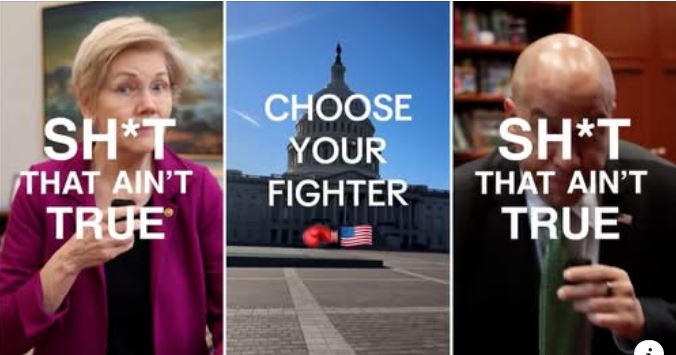How Democratic lawmakers are turbocharging their presence online — both as content creators and collaborators with other influencers.
The videos garnered millions of views but were widely mocked by Republicans and condemned by some Democrats as evidence of why the party’s messaging isn’t landing with voters. Republicans put the senators’ videos side-by-side to show the overlap, with Elon Musk promising a Cybertruck to anyone who could prove who wrote the “piece of propaganda.” Meanwhile, the “choose your fighter” video was ribbed by the White House rapid response account, called “cringeworthy” by House Speaker Mike Johnson (Louisiana) and mocked as an embarrassment to all involved by Jimmy Kimmel on the late-night circuit.
Democrats say the election laid bare the need to try to replicate the creator ecosystem on the right, and since their loss in November, they have stepped up efforts to adapt to the new media environment. But plenty of disagreements remain about what works, and those leading the effort are aware they’re starting from behind.
Making Democratic lawmakers creators
In their efforts to double down on social media, Democratic members of Congress are going beyond what’s typically been expected of legislators over the past decade: They’re trying to become political influencers.
In the House, the Democratic Policy and Communications Committee (DPCC) is providing members with the materials and direction they may need to create their own videos and hiring a first-ever digital partnerships manager to work with the caucus. Last year, the committee provided lapel mics to every Democratic member and hand-delivered booklets to each office on the best digital strategies.
Democrats say the election laid bare the need to try to replicate the creator ecosystem on the right, and since their loss in November, they have stepped up efforts to adapt to the new media environment. But plenty of disagreements remain about what works, and those leading the effort are aware they’re starting from behind.
Making Democratic lawmakers creators
In their efforts to double down on social media, Democratic members of Congress are going beyond what’s typically been expected of legislators over the past decade: They’re trying to become political influencers.
In the House, the Democratic Policy and Communications Committee (DPCC) is providing members with the materials and direction they may need to create their own videos and hiring a first-ever digital partnerships manager to work with the caucus. Last year, the committee provided lapel mics to every Democratic member and hand-delivered booklets to each office on the best digital strategies.
“This is a collection of 47 content creators,” a staffer involved in the Democratic Strategic Communications Committee’s (SCC) efforts said of the party’s 47 senators, including two independents who caucus with Democrats. The staffer, like others interviewed for this report, also spoke on the condition of anonymity to freely discuss the work of the committee, which is hiring additional staff to support its efforts.
In the Senate, the Booker-chaired SCC is driving the creator-focused work. Booker, an early adopter of Twitter and a fan of selfie-style videos, said he approached Minority Leader Charles E. Schumer (New York) last year about leading the committee because of his concerns that Democrats were getting “shellacked” online compared with the right-wing media ecosystem, which he noticed was picking up and elevating content put out by GOP senators.
Booker said he sees his role as SCC chair as encouraging his colleagues to take the energy they’d bring to a town hall and instead put it on a digital platform. In January, he gave his first presentation to the Democratic caucus lunch as SCC chair, showing his colleagues how the false claim that Haitians were eating pets in Springfield, Ohio, had first spread through members of Congress before it was covered by the media.
Calling the talk the “anatomy of virality,” he pointed to how Republicans were able to get their message — “whether it was Joe Biden tripping and falling or Ted Cruz going on a rant” — in front of voters, while Democrats were not. The committee has since created what members internally refer to as “S— that ain’t true” videos, like the one that went viral last week, to try to counter such messaging.
Normally senators don’t each film the same video, as they did the day of Trump’s address to Congress, but Booker said the videos were a “Trojan horse” to get their message shared within the GOP.
While the videos did draw attention from the right, many Democrats — including within Congress — questioned whether it was a smart move.
“We are more interested in members just doing stuff rather than parroting talking points,” the House aide said. When asked whether they thought the Booker-organized video was authentic, the aide said, “Oh my God, of course I don’t.”
Rachel Janfaza, a Gen Z political analyst and founder of a nonpartisan political newsletter focused on Gen Z politics, said the joint session videos read as “staged and inauthentic.”
Young audiences, she said, “don’t want to feel as though all of the Democrats are churning out the exact same thing or have been in cahoots with one another about what they’re supposed to be posting.”
Collaborations, cross posts and influencer row
Democrats in both chambers are also ramping up their engagement with creators. They’re inviting influencers to the Hill to meet with lawmakers more frequently and are doing more appearances on new media. Such efforts have also been a focus of conversation during the annual House Democrats retreat this week, with members acknowledging that they are behind and need to crack the code on reaching new audiences.
Drawing on concerns they heard from people working in the creator space during the campaign, congressional staffers have focused on providing more direct contact between creators and lawmakers. “What we’ve attempted to do on the House side is create our usual media events for members like media row, but then incorporate an aspect of it that’s digital focused,” the House aide said. Democrats in both chambers suggested that the end game is likely to be a system of sorts for credentialing creators to cover the Capitol like reporters, though conversations are still in the early phases and there are many logistical questions that would need to be addressed.
For the joint session, Democrats brought about 40 creators in to meet with more than 150 House members. Sulhee Jessica Woo, an influencer known as the “bento box queen” who built an audience of millions while making lunch for her daughters, was invited to the Capitol by Chorus, a new collective that supports creators advocating for Democratic causes and policies. She is the influencer behind the viral “choose your fighter” video.
“The only people who think that the video is cringey are older people that don’t do TikToks,” Woo said. “Gen Z [people] in my comments are like, ‘Love it.’ They think it was just another video. They probably even scrolled, they didn’t even think twice.”
Woo and other creators said Democrats have been far more open to working with them since the election, though some noted that the types of creators invited to such events are limited.
“Insofar as they were open to it at all, yes, they seem more open to it,” said progressive creator Brian Tyler Cohen, whom the SCC brought in to speak to Democratic senators in February and who returned to the Capitol for the joint session. “This is a whole new world for them.”
Olivia Julianna, 22, a Democratic content creator and strategist, said she saw a shift in Minority Leader Hakeem Jeffries’s approach after he met with a small group of content creators at the Democratic National Convention in August.
He has since upped his engagement on various platforms and made recent appearances on many live streams and podcasts like “The Meidas Touch Podcast.” Jeffries has talked sports with Stephen A. Smith and Tony Kornheiser and participated in long-form conversations on Katie Couric’s YouTube, in addition to posting a more casual video in his office wearing a hoodie while criticizing a Republican lawmaker.
But many of the influencers whom Democrats are interacting with most are no strangers to the Democratic circuit, like Harry Sisson and Chris Mowrey, who made videos with senators after the joint session. Some Democrats said that while they’re pleased the party is doing more, they’re concerned about an overreliance on the same well-known people — creators seen as friendly or safe to collaborate with.
“Democrats are so afraid of doing or saying the wrong thing that only certain people have been invited into spaces,” Julianna said, adding that the party often makes content like “inside baseball.”
“We need to be more open to talking to people who have strong disagreements with us, because if we don’t, we’re going to continue to fail,” said Julianna, who said she has not been invited to any creator events since the election and has been told she’s too moderate to be in some creator spaces despite speaking at the Democratic National Convention.
Janfaza, the Gen Z analyst, said that “while there’s certainly a place for sort of entrenched Democratic and aligned activists, the ecosystem needs to be broadened to include creators who are typically not talking about politics and might not be aligned with one party or another.” She praised the inclusion of some nonpolitical creators at the joint session, like Morgan Riddle, who is popular online for posting about her style and life as the girlfriend of tennis player Taylor Fritz.
The aide involved in the SCC effort said they would try to engage with more lifestyle and politics-adjacent creators down the line: “We got to crawl before we can walk, walk before we can run.”

